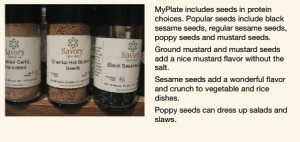10 Tricks for Healthy Italian Food

 1. Lower the fat. Measure olive oil -- don’t just pour some into a pan. Although olive oil contains healthy fats, it is also extremely calorie dense. Using a nonstick skillet will also help you cut down on the amout of oil a recipe needs.2. Lighten up the cheese. Opt for small amounts of flavor- ful cheese like Parmesan or Romano cheese. Try using fat-free ricotta in place of regular ricotta.3. Lighten the protein. Use high-fat items like sausage or ground meat very sparingly, if at all. Boost their flavor with ground fennel seed. Fish, seafood, and white poultry are better choices.4. Emphasize whole grains, vegetables, and fruits. Use meat as a flavoring or side dish, not the main attraction.5. Eat whole grain pasta. Choose whole grain pasta instead of white pasta wher- ever possible. Whole grain pasta contains more fiber and nutrients and is super easy to prepare.6. Make low-sodium choices.See if you can find pasta sauce with no salt or at least less than 400 mg of sodium per serving. You can lower the sodium in prepared pasta sauce by adding no-salt- added canned tomato sauce.7. Eat lots of tomatoes. To- matoes are high in vitamins A & C and are a good source of potassium. They also contain lycopene, a phytochemical that may help prevent certain cancers.8. Use broth instead of cream. Broth makes an excellent pasta sauce. Add mushrooms, basil, thyme, and rosemary for more flavor.9. Go easy on the bread. Bread is calorie dense and it is easy to eat too much of it, especially in Italian restau- rants where baskets of bread tend to be bountiful.10. Use flavorful herbs. Use herbs instead of salt to sea- son your meals. Italian cooks use generous amounts of basil and oregano along with mushrooms, sun-dried toma- toes, fresh parsley, garlic and onions.
1. Lower the fat. Measure olive oil -- don’t just pour some into a pan. Although olive oil contains healthy fats, it is also extremely calorie dense. Using a nonstick skillet will also help you cut down on the amout of oil a recipe needs.2. Lighten up the cheese. Opt for small amounts of flavor- ful cheese like Parmesan or Romano cheese. Try using fat-free ricotta in place of regular ricotta.3. Lighten the protein. Use high-fat items like sausage or ground meat very sparingly, if at all. Boost their flavor with ground fennel seed. Fish, seafood, and white poultry are better choices.4. Emphasize whole grains, vegetables, and fruits. Use meat as a flavoring or side dish, not the main attraction.5. Eat whole grain pasta. Choose whole grain pasta instead of white pasta wher- ever possible. Whole grain pasta contains more fiber and nutrients and is super easy to prepare.6. Make low-sodium choices.See if you can find pasta sauce with no salt or at least less than 400 mg of sodium per serving. You can lower the sodium in prepared pasta sauce by adding no-salt- added canned tomato sauce.7. Eat lots of tomatoes. To- matoes are high in vitamins A & C and are a good source of potassium. They also contain lycopene, a phytochemical that may help prevent certain cancers.8. Use broth instead of cream. Broth makes an excellent pasta sauce. Add mushrooms, basil, thyme, and rosemary for more flavor.9. Go easy on the bread. Bread is calorie dense and it is easy to eat too much of it, especially in Italian restau- rants where baskets of bread tend to be bountiful.10. Use flavorful herbs. Use herbs instead of salt to sea- son your meals. Italian cooks use generous amounts of basil and oregano along with mushrooms, sun-dried toma- toes, fresh parsley, garlic and onions.